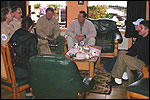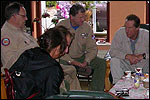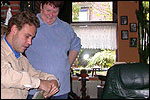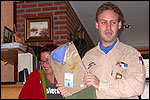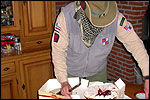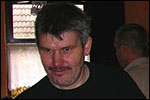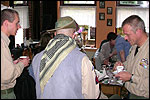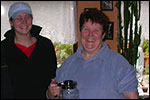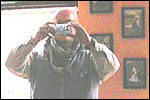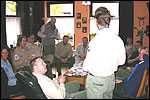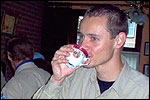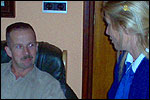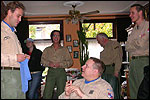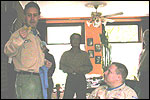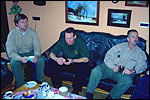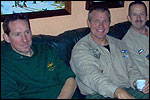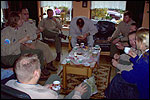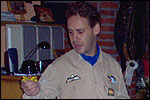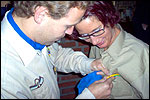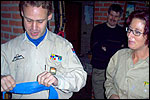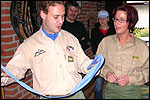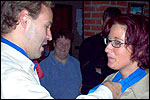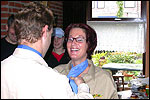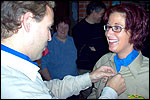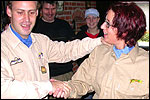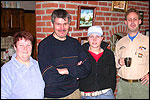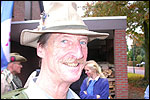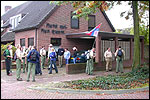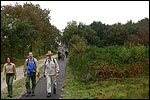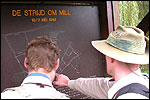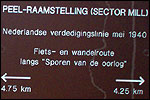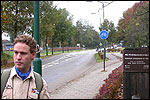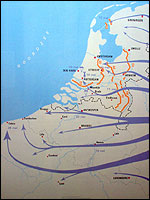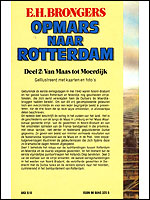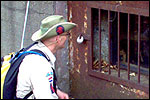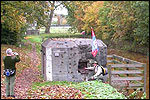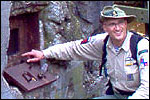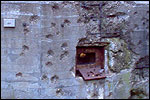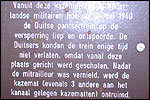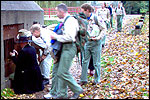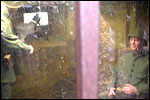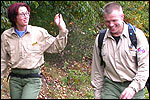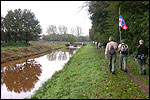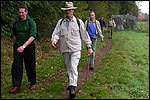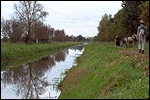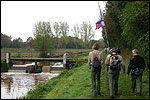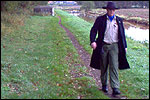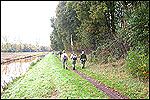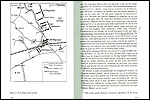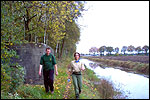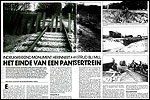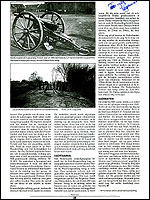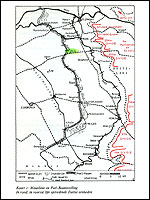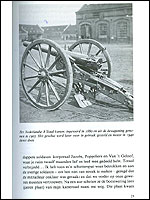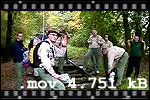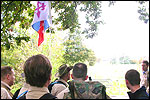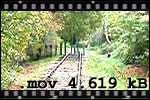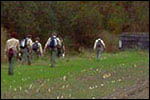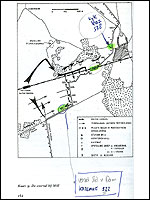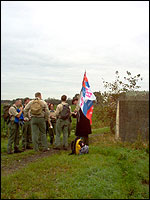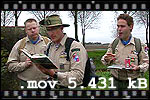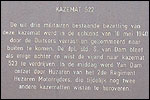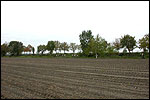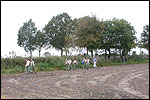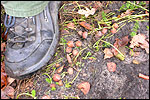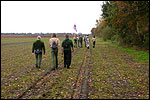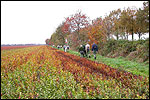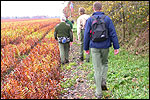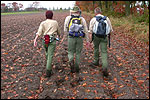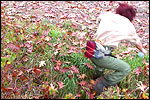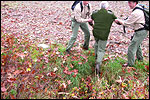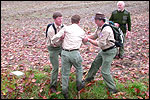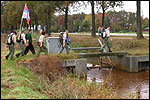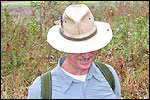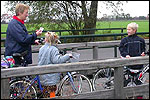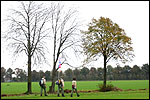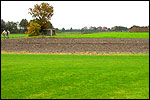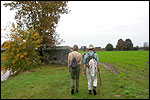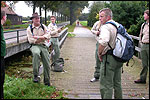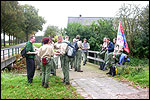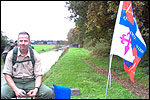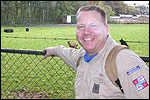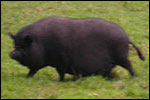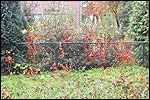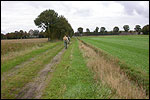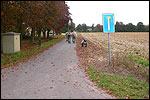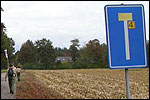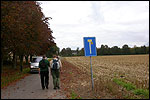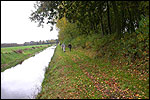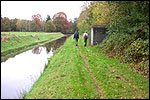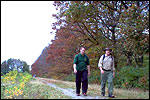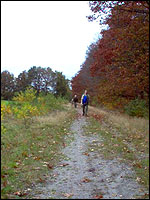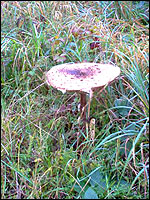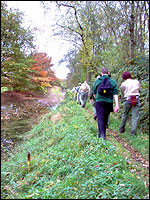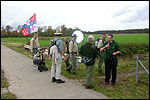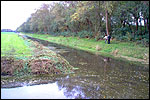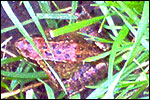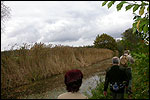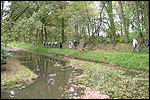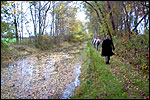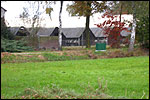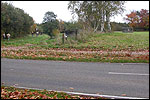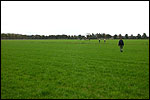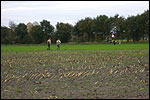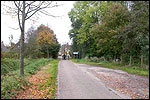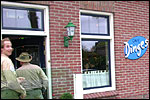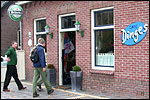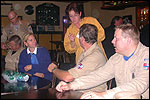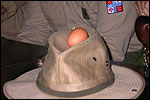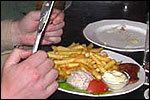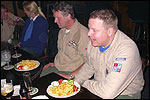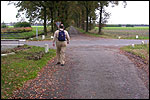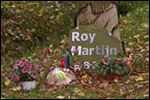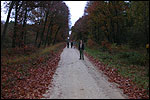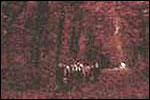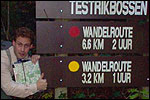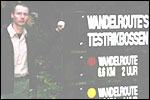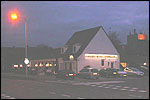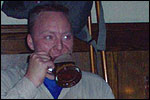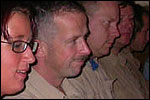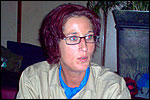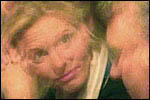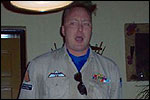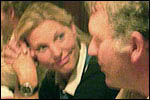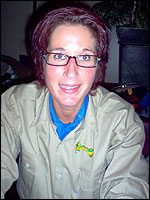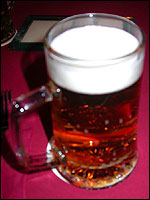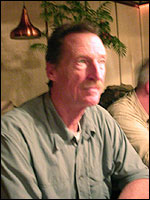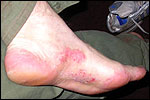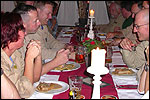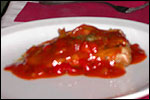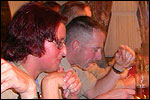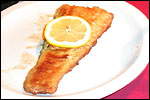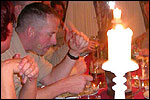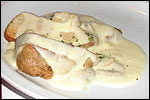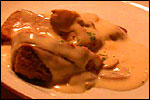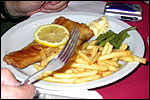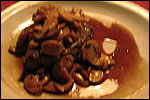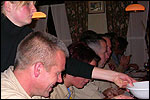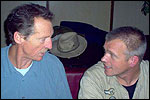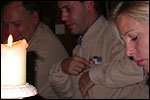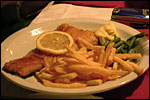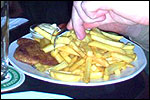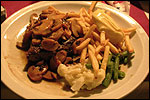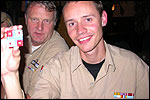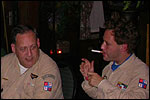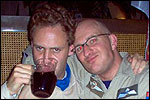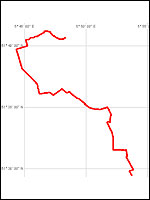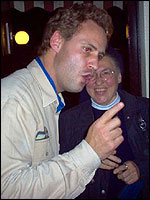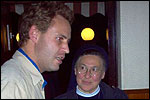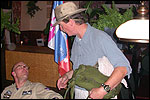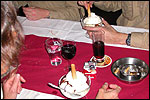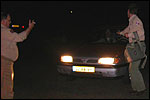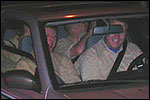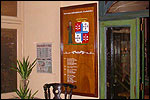| What are we doing?
October 31st, 2004 Across the Netherlands from Top to Toe: St. Hubert-Ysselsteyn THAT'S how these things go. And thank God too. For we had no longer expected that. Hadn't expected, that today would produce a nice walk - because the Secretary had repeatedly warned us that it was going to be a "dreadful, long stretch along a canal". Had no longer expected, that Alberta Regts-Vrooland, Fred's wife, would ever find time to walk with us (for she already hadn't shown up at a march along our regular practice course, that I'd organized for her). And had no longer expected, that Pieter Spaan would ever bestow on us the honour of marching with us - for who would expect that, from a man pronounced terminal, and very much busy with other walks? 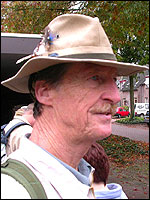 Yet that all happened today. And that made today a memorable day. This already began in St. Hubert, where, as Wandelsoc., we logically returned, because the last stage of our practice project, 'Across the Netherlands from Top to Toe', had ended there. Logically, but unusual, because, in St. Hubert, we did not start from a local catering establishment, but from the home of former commando Huub van Straaten, his wonderful wife Jacqueline, and their kids Ilona and Eef. Eef was still asleep, having returned late, from the bar. But sister Ilona, back late from the bar too, was awake. To the great joy, of just about everyone, of ours. Yet that all happened today. And that made today a memorable day. This already began in St. Hubert, where, as Wandelsoc., we logically returned, because the last stage of our practice project, 'Across the Netherlands from Top to Toe', had ended there. Logically, but unusual, because, in St. Hubert, we did not start from a local catering establishment, but from the home of former commando Huub van Straaten, his wonderful wife Jacqueline, and their kids Ilona and Eef. Eef was still asleep, having returned late, from the bar. But sister Ilona, back late from the bar too, was awake. To the great joy, of just about everyone, of ours.
Jacqueline supplied us with coffee, until Weij arrived, with his cake. He'd namely just had his birthday (on the 24th, and become 40). And so, we sang for him. Other than that, he passed the cake around without ceremony. Reason, for Schelden, to immediately launch into ceremony: presenting, namely, Anita Willemsen with the sissy-ish blue choker. You see, he had, only recently too, gotten her to get herself into a Society outfit. Reason enough to add a cheerful women's version of the Four Day Marches' Cross, to that choker. Which she accepted in gratitude too. It shall remain a miracle to me: we have a female Member. We already did, but she never walks with us anymore, and therefore this is nice. So that was a fine start, to a day that would bring us more brilliance. The group portraits past, we (Henk van der Schelden, Marco van Zijntergen, Albert van Geyningen, Peter Weij, Marco Neumann, Raymond de Gisser, Fred Regts, Jan Middelkoop, Barend Rijkman, Dick van Kuppevelt, Anita Willemsen, Marjon van Dijk, Pieter Spaan, the newly recruited former commando Erwin de Wijs and yours truly) laid down a brisk pace, from St. Hubert, via Mill to the start of where Peter wanted us to get to: he had namely, in advance, concocted, with Schelden, that this part of our journey from Schiermonnikoog to Aken was to follow the path of one of Holland's most renowned lines of defence (the other two, of course, are Kornwerderzand and the Grebbeberg, and we leave aside the Dutch Waterline, because it is, admittedly, illustrious, since 1672, but played no role of importance during the Maydays of 1940): the Peel-Raamstelling. 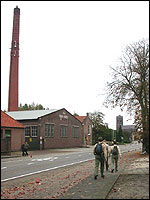 There, our Dutch army, although fruitlessly in the end, namely gallantly, and unexpectedly efficiently, fought the German occupier in those Maydays of '40. And because that line of defence has remained largely intact, Peter felt it would be a nice and a sensible idea to follow it for a good bit. No sooner said than done. And we had, in advance, been scared considerably, by Schelden, because he predicted it was going to be "an endless trek by a long canal", which made visions of Drenthe, south of Coevorden, appear before our mind's eyes. There, it was vast, and straight. Here, it was none of all that. For what we were confronted with, following a brief inspection of the, heavily peppered, first bunker in our path, splendidly furnished with a permanent diorama of Dutch defenders, was a wonderful walk by meandering water, along forest and farmland too, with, indeed, casemats dotted along them at every few hundred metres. There, our Dutch army, although fruitlessly in the end, namely gallantly, and unexpectedly efficiently, fought the German occupier in those Maydays of '40. And because that line of defence has remained largely intact, Peter felt it would be a nice and a sensible idea to follow it for a good bit. No sooner said than done. And we had, in advance, been scared considerably, by Schelden, because he predicted it was going to be "an endless trek by a long canal", which made visions of Drenthe, south of Coevorden, appear before our mind's eyes. There, it was vast, and straight. Here, it was none of all that. For what we were confronted with, following a brief inspection of the, heavily peppered, first bunker in our path, splendidly furnished with a permanent diorama of Dutch defenders, was a wonderful walk by meandering water, along forest and farmland too, with, indeed, casemats dotted along them at every few hundred metres.
This couldn't get much prettier, and it was historically sound too! As was proven all the more, when Peter, there where the asparagus sticks again, by way of monument, rise slantingly from the rails, told us about the demolition of a German armoured train (from which, shortly before, a batallion of Germans had been dropped behind Dutch lines), which derailed on those sticks upon return, and was riddled with shots, while the batallion dropped from it subsequently got a very bloody nose from steel cannons dating back to 1880(!), that were placed nearby. Shame it didn't help, but an impressive bit of history. As, some kilometres onward, was the story of conscript soldier van Dam, who, after both his companions in casemat 522 had been taken prisoner by the Germans, defended that casemat so furiously, that he beat back the Enemy to casemat 523, and kept them there until he was relieved by Hussars (on motorcycles), who found him in 'deplorable and exhausted condition'. Magnificent. And reason, by the way, for Schelden, to, on behalf of the Occupier, deny this version of events in roaring High German, and to claim a valiant victory for the Stahlhelm. Marvellous. And it all remained marvellous, although that was increasingly less due to the Peel-Raamstelling, because, from here, we did continue to walk parallel to it, but hardly saw it anymore. What we did see, this most intensively, was mudclumpish farmland, through which the going was heavy, but beautiful, through freshly lifted fields of carrots, and less recognizable autumncoloured crop, freshly harvested peony rose, according to our Westfrisian. Pleasant sinking away, and plodding sweating, until we arrived at a Ditch. Which most certainly did not deserve that capital as a ditch - and noone was therefore troubled by crossing it. Noone, but for our Guide and Great Leader, van der Schelden MA. Who was suddenly scared out of his Soc.-pants, who, one by one, and with much ado, handed all his possessions across the Ditch to the former commandoes waiting on the far side, as if this were a Great Dying (the fact that he could just hand them over should have assured him that his skinny legs would manage too, but no) and who, with even more ado, threw a fit over my camera, logically kept at the ready (splendid action shots, those jumps over the ditch make for, after all), so that it all began to look like a rerun of the camera-row of 2003 in Diekirch and the Ditch did after all earn itself that capital D. I, of course, added insult to injury by, as Schelden lamented over his complaints ("I've got a weak spot in my knee, asshole!") and threatened to whack the camera from my hands, needling "Jump! Jump, motherfucker!". But alas, it was not to be helped: Schelden made it across, cursing, but undamaged. This, afterwards, did produce many a side-split, whilst we bravely pushed on. Because that was what was needed here, for a while, because not so much that Ditch, but the fieldplodding had taken its toll on our legs. And as we pushed on, I got more and more cross, over that Moaning of Schelden's by that Ditch. So at the next rest, on a lost little bridge in the middle of nowhere (which we reached after a pleasant hard trod along an unrealistically shorttrimmed nongolf lawn, and, golly, some more bunkers of the Peel-Raamstelling), I flew at him. "Say, would you please whack that camera from my hand next time? 'Cause Neumann has taught me how to hit people, in Diekirch, and I'm itching to try out what I've learned! Dog breath! Rat! Worthless nincompoop!" And so on, and so forth. Lovely, for quite a relief. Then, we all merrily hit the coffee Peter had brought along, and we were therefore warm to walk again soon, because of that too. And this was necessary, since we weren't there yet, by a long shot. Weren't where? There. In uh... ...Café uh... ...uh... ...Whatever. That - ('Dinges', which is Dutch for 'whatever' or 'you know what') - was really, fabulously, what it was called, but this was in Westerbeek, and before that we had quite some walking to do. By roguish bioboars, through ominously dead-ended roads, along more Peel-Raamstelling (longer than you'd think, such bunkerstring), through beautiful autumnish woods, along uncommonly uneven paths, past a fortified animal farm (which we therefore suspected to be a mink breedery, although, in hindsight, the furtively taken long distance photo would show them to be enormous minks in that case, of kangaroo size namely), and, oh joy, totally illegally, straight through, thankfully already harvested, cornfields. The topographical map was finally put to good use. Exhausted and sweating, but happy, we therefore arrived in Westerbeek, at Café Dinges, fine establishment, of the dark brown kind that evokes memories of Café-Restaurant Vloedgraven and, very slightly, of Eethuys Dorestad. Where, therefore, we much enjoyed the beer, the milk (no butter- available, as so often), the coffee, the orange juice, and the food (sandwiches brought along, but also festive fries-with-satestuff). And also, we were awaited there by the minis of today. They're Soccers too socially weak to dare to test their minds and bodies in solitude, by using our regular practice trajectory towards Katwijk for their training, and because of this, so long as they can't physically handle more, disturb our Marchleader in organizing his endeavours, meant for harder folk, so that they can then march part of those with the rest of us. Quod erat demonstrandum: see, for instance, at the previous stage, Max and Marjon. And that the Marchleader falls for this, is logical. He, after all, gets a boner when people prefer walking with him above hard, but more instructive toiling along the coastline. But that these people do so, nonetheless is half-hearted, dumb behaviour. I can't call it anything else. I've never seen those minis successfully complete a Nijmegen. That's all I'm saying. Which doesn't mean we weren't happy to see them. Since it's always great, to arrive in some strange place wasted and steaming, and then run into your own Society uniform. All the more so if it is stretched over the huge torso of our founder. For there was Max, with Marjon, and also Alberta, Fred's charming wife. Lightly inebriated by now, it was high time to drive them across hard surface for a while (sadly, this no longer happened with Neumann, as he made himself mini by quitting here - although we had to forgive him for that later, when we saw his soles). This succeeded, for what was to come yet, was beautiful. Following a somewhat boring tree-lined avenue, along which the only enlivening things were, sadly, the roadside monument for Roy Martijn, gone from us too early (the cause of which quickly became apparent when we were passed, at 180 k an hour, by some idiot), and a considerable intteruption on my part (I had to go and shit incredibly all of a sudden, typical, just when you've left some bar a few kilometres ago, but thankfully, I found an incredibly friendly local who came to my aid and willingly let me destroy his closet), we marched into the gorgeous Testrik woods (and past the base of the Group Guided Weapons de Peel, the guys with the better job within Defense, because they get to practice with those things in places like Crete). Once through those, we crossed quiet farmland (where Pieter saved my mobile phone by picking it up for me, from the muddy tractor trail into which it had landed, having sprung from my belt), sucking Chokotoffs (de Gisser and I, anyhow), into Ysselsteyn, to Herberg (Inn) de Peel. And there, it turned out that those end-of-day bacchanals of ours are now really getting to be much like those of Uderzo and Goscinny: it was merry, there was fine food (provided by a, clearly overworked because of it, but nonetheless bravely friendly, and utterly correct staff, waitress Rachida being its frontline), much drinking, loud speeching ("We're going to give four rounds of applause, and afterwards I'm gonna tell you what they're for") - and no (or at least almost no) singing by the bard, who was namely much too busy besieging unexpecting nuns, 1 table up (and did after all sing a little whilst doing so). And so, before we knew it, it was late by the time we decided to sound the retreat. Nonetheless, I was in the Souteneur, Society café in Haarlem, in time to raise a last glass there with Max, Marco, Marjon and Henk. Pleasant, pleasant, pleasant. To your health, gentlemen, ladies, excellent walking there. Aachen awaits. |
